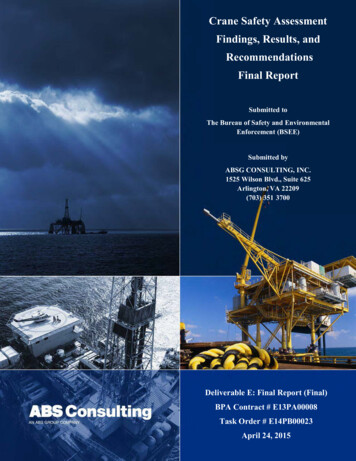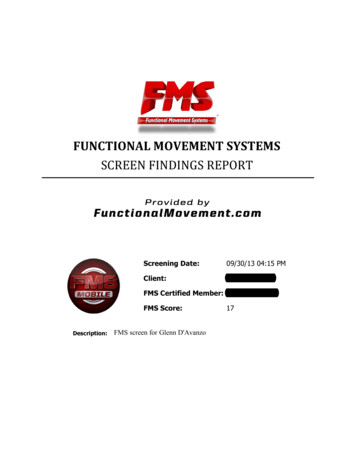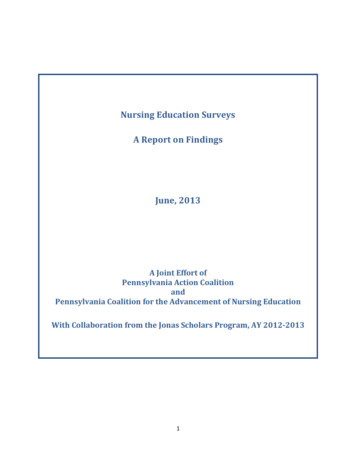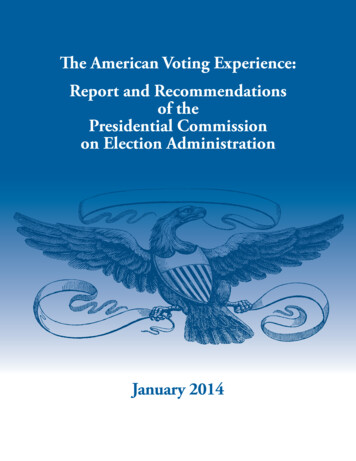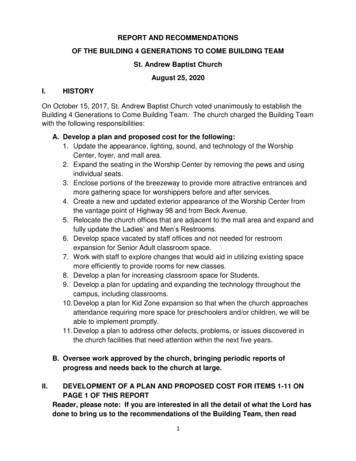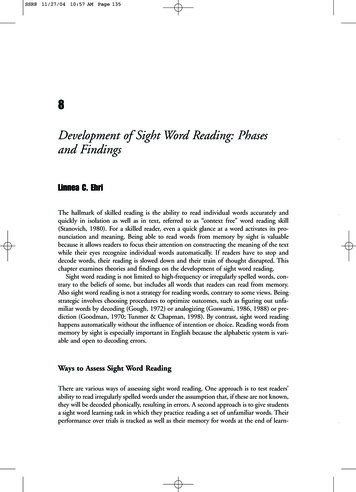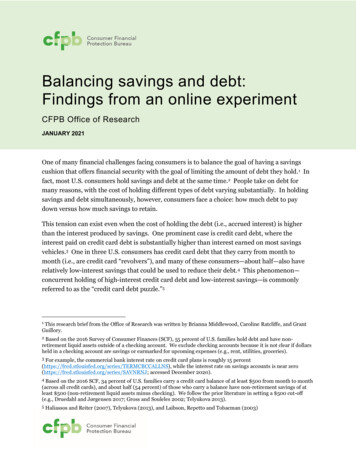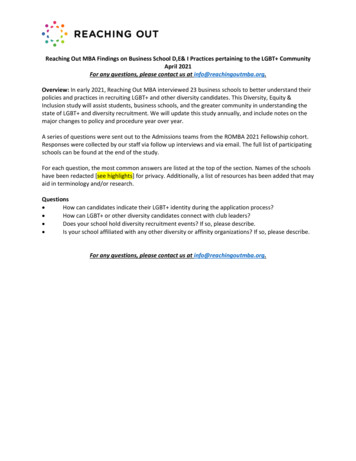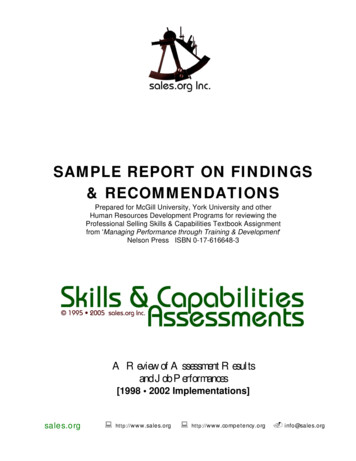
Transcription
SAMPLE REPORT ON FINDINGS& RECOMMENDATIONSPrepared for McGill University, York University and otherHuman Resources Development Programs for reviewing theProfessional Selling Skills & Capabilities Textbook Assignmentfrom 'Managing Performance through Training & Development'Nelson Press ISBN 0-17-616648-3A Review of Assessment Resultsand Job Performances[1998 2002 p://www.competency.org. info@sales.org
.sales.org nfo@sales.orgSample Report on Findings & Recommendations.TABLEOFCONTENTS.SECTION TITLE.PAGE NUMBERTABLE OF CONTENTSiEXECUTIVE SUMMARYiiAssessment Categories and Result Comparisons1Relationship of Skills & Capabilities to Psychometric Results7Skills & Capabilities Assessments Findings8Skills & Capabilities Assessments Recommendations10AppendicesØ INDEX14Ø Skills & Capabilities Assessments - Design Methodology & Construct Validation15Ø Skills & Capabilities Assessments - Sample Performance Charts17Ø Five Levels of Learning - Canadian HR Reporter Article19Ø Training for Competency vs. Training for Knowledge - Canadian HR Reporter Article21Ø Three3 Learning Matrix23Ø Sample Report - Management Skills & Capabilities Assessment24 1998 2005 sales.org Inc. All Rights ReservedSample Report on Findings and RecommendationsSkills & Capabilities AssessmentsPage i
.Sample Report on Findings & RecommendationsExecutive SummaryAssessment Objectives, Comparison ofAssessment Scores to Performance Results, &Other Findings.Assessment ObjectivesThese Skills & Capabilities Assessments were created to support the recruiting selection,development and alignment of best practices personnel to roles and responsibilities.The primary objectives of Skills & Capabilities Assessments are to sample, measure, andreport on strengths, identify gaps in knowledge and judgments, and to evaluate the level ofjob related complex competencies that each individual demonstrates. This assists andenables Managers in putting the best people into the right roles with the necessarycompetency to meet and fulfil client needs and goals.A secondary objective for the Skills & Capabilities Assessments is to measure and identifyboth individual and organizational learning opportunities that can be quickly and directlyapplied to both actions and performance results. This process helps to increase the ROI ontraining investments.A third objective of the Skills & Capabilities Assessments is to measure the overallcompetency of both new hires and employees leaving the role, to measure theeffectiveness of recruiting and retention of top performers. This helps to support andincrease both the ROI and ROE of corporate intellectual capital.Finally, Skills & Capabilities Assessments are intended to provide additional support forongoing identification, creation, and implementation of programs specifically designed toimprove sales performance development for both individuals and the organization. 1998 2005 sales.org Inc. All Rights ReservedSample Report on Findings and RecommendationsSkills & Capabilities AssessmentsPage ii
.Comparison of OverallSkills & Capabilitiesto Job PerformanceLinking Assessment Scores to Business ResultsPerhaps the most essential question for this report to answer is what relationship individualAssessment scores have to real performance results. Because this question is at the heart of thevalue, credibility and usability of the Assessment conclusions, we have chosen to open this reportwith review of those findings:Skills & Capabilities[Overall Averages] Top Quartile 2nd Quartile 3rd Quartile 4th QuartilePerformance AveragesTo .4%99.5%98.9%91.7%97.8%Table 1The following table shows the relationship between scores and personnel retention.Skills & Capabilities[Overall Result] Top Quartile 2nd Quartile 3rd Quartile 4th QuartileTransfers &TerminationsLeft FirmChanged 1.4%100%100%100%100%Table 2 63% of those who left scored in the top two Quartiles on Skills & Capabilities57% of people who left their roles scored in the top two Quartiles on Skills & Capabilities72% of people who left the role with scores in the bottom two Quartile were retainedNOTE:These numbers represent a consolidation of data from several firms. For the purpose of both confidentiality andconsistency, dollar figures and specific definitions of performance measurements have been reported in generic terms. 1998 2005 sales.org Inc. All Rights ReservedSample Report on Findings and RecommendationsSkills & Capabilities AssessmentsPage 1
.Assessment Categoriesand Comparisons of ResultsMeasuring & Managing theRight Skills & CapabilitiesCommunication, Sales, & Relationship Building SkillsThe original Skills & Capabilities Assessments were developed to sample and evaluate thenegotiating and influencing (Relationship Selling) skills of professionals and salespeople. Beforereviewing the categories and sub-categories of skills being measured, the following table provides acomparison between results across sample segments on those common influencing skills:Communication and Negotiating (Selling) Skills & Capabilities AssessmentsCATEGORYListeningPERFORMANCE AVERAGES BY GROUPCREDITBANKING .2%48.4%58.5%53.0%55.7%55.4%Relationship 5.6%52.5%48.0%48.9%54.3%Table 2FINDINGS Skills & Capabilities Assessments score the same gaps in core listening and questioning skills that arereported in Industry Benchmarking reports and Customer Satisfaction surveys Sales and negotiating training (generally) results in a negative impact on performance. The GeneralPopulation sample averages approximately 0.3 sales or negotiating training programs, the U.S.Government averaged 1.1 (primarily winning negotiating strategies) , and the insurance industry had a1.4 average. The banking industry averaged 3.6 sales and negotiating programs over the past tenyears, well above that of other sample groups None of the sales and negotiating training programs reported and reviewed incorporate skill andcompetency development of the fundamentals of communication or decision making principles concentrating instead on processes and techniques to lead customers to desired outcomes.CONCLUSIONNew and additional emphasis on core communication and influencing skills is required. 1998 2005 sales.org Inc. All Rights ReservedSample Report on Findings and RecommendationsSkills & Capabilities AssessmentsPage 2
LISTENINGPARTICIPATIVE Actively acknowledging the speaker Supporting and encouraging the speaker Making the best possible use of appropriate posture, gestures, and expressions to confirm interest andinvolvement in discussionsSITUATIONAL Identifying information based the context it is presented in Recognizing when information is being presented in either a positive or negative context to influence thelistener's judgment Differentiating and discerning meaning in messages involving nuance or ambiguity Validating the relevance of the information to the topic of discussion Sensitivity to social, cultural, and situational factorsENVIRONMENTAL Understanding and managing the influence of other listeners in a group setting Minimizing the effects of noise and factors of location to improve concentrationNON-VERBAL Ability to recognize and interpret the non-verbal clues and cues that add to the effective meaning of thespeaker Ability, in a socially and culturally acceptable manner, to use non-verbal clues and cues as aparticipative listenerFINDINGSSome of the more common and consistent gaps, issues, and opportunities for improving ListeningSkills come from the following areas: Overconfidence in listening abilities is prevalent in all samples. This is particularly true with individualswho scored in the bottom two Quartiles. It is also true for the majority of Managers tested at the sametime. Overconfidence is a proven barrier to both performance and to learning effectiveness. One of the more prevalent, and disconcerting problems identified is the assumption of superiorknowledge and understanding and the importance of interrupting or controlling content being presentedby others Awareness of the influence that personal experience and bias have in interpreting and understandingwhile listening are substantially lower in the banking sample than in all other groups The banking sample demonstrated one of the lowest scores for areas involved in understanding andavoiding listening behaviors that can negatively influence the listener's presentation, understanding andjudgmentCONCLUSIONListening (comprehension) is a foundation skill, required to support questioning, presenting, anddecision activities. The problems identified above are compounded by a variety of techniques andhabits that have been introduced that may encourage the use of assumptions and superiorknowledge to (unduly) direct and control discussions, including those related to needs analysis andfact finding. While most industry sample scores are low, scores for the general population arehigher indicating that the public will more readily recognize and react to poor listening behaviours.Obvious problem in building relationships with clients, this also places the tested individuals at asubstantial disadvantage in discussions and negotiations in competitive situations. 1998 2005 sales.org Inc. All Rights ReservedSample Report on Findings and RecommendationsSkills & Capabilities AssessmentsPage 3
QUESTIONINGThis category measures a number of skills that impact the effectiveness of questioning. Theseinclude methodologies provided in Bloom's Taxonomy of Questioning. The following is anoverview that captures a number of these questioning elements, what those elements examine, andexamples:KNOWLEDGE remembering memorizing recognizing recalling identification recall of information Who, what, when, where, how .? Describe ?COMPREHENSION interpreting translating from one medium to another describing in one's own words organization and selection of facts and ideas Retell.?APPLICATION problem solving applying information to produce some result use of facts, rules and principles How is.an example of.? How is.related to.? Why is.significant?ANALYSIS subdividing something to show how it is put together finding the underlying structure of a communication identifying motives separation of a whole into component parts What are the parts or features of.? Classify.according to. ? Outline/diagram. ? How does.compare/contrast with.? What evidence can you list for.?This first group of descriptions represents the more common, basic, and less impactful questioningapproaches. While better than not asking, these questions are not generally effective at elicitingresponses that include either emotional or intellectual commitment and interest.FINDINGSPredominantly most samples of Questioning Skills fell into the first two sub-categories, Knowledgeand Comprehension. See the next page for further details, findings, and Conclusions. 1998 2005 sales.org Inc. All Rights ReservedSample Report on Findings and RecommendationsSkills & Capabilities AssessmentsPage 4
QUESTIONING (CONTINUED)Of greater value and importance are the understanding, application, and regular use of moreadvanced skills that elicit situational, personal, and other essential decision-making information.SYNTHESIS creating a unique, original product that may be in verbal form or may be a physical object combination of ideas to form a new whole What would you predict/infer from.? What ideas can you add to.? How would you create/design a new.? What might happen if you combined.? What solutions would you suggest for.?EVALUATION making value decisions about issues resolving controversies or differences of opinion development of opinions, judgements or decisions Do you agree.? What do you think about.? What is the most important.? Place the following in order of priority. How would you decide about.? What criteria would you use to assess.?PREPARATIONIn addition to Bloom's methods and descriptions, The Assessment reviews the following aspects ofquestioning skills of the participants: Planning and organizing questions in the most effective order Scripting, practicing and refining questions [including Open vs. Limited probing] Anticipation and analysis of related and secondary considerations Adaptability and flexibility in responding to unexpected responses and circumstancesFINDINGSSome of the more common and consistent gaps, issues, and opportunities for improvingQuestioning Skills for training & development come from the following areas: The full range of questioning skills in these samples are weak There are significant gaps in planning, organizing, preparation and scripting There is confusion over the difference between questions, objections and complaints, and a clear gapon the essential actions and processes necessary to resolve each from the client perspectiveCONCLUSIONThere are significant learning needs and opportunities in training and coaching efforts to buildquestioning competencies in order to increase capabilities across all communication and influencingskills category.The most significant gaps between the industry samples and best practices come from the'Preparation' subset of skills, with very low performances under planning and preparation, and evenlower scores related to questioning around assumptions. Even those whose scores were in the topQuartile provided responses to the assessment that suggest there is a greater focus on questioning 1998 2005 sales.org Inc. All Rights ReservedSample
Sample Report on Findings and Recommendations Skills & Capabilities Assessments Page 4 QUESTIONING This category measures a number of skills that impact the effectiveness of questioning. These include methodologies provided in Bloom's Taxonomy of Questioning. The following is an overview that captures a number of these questioning elements, what those elements examine, and examples:
